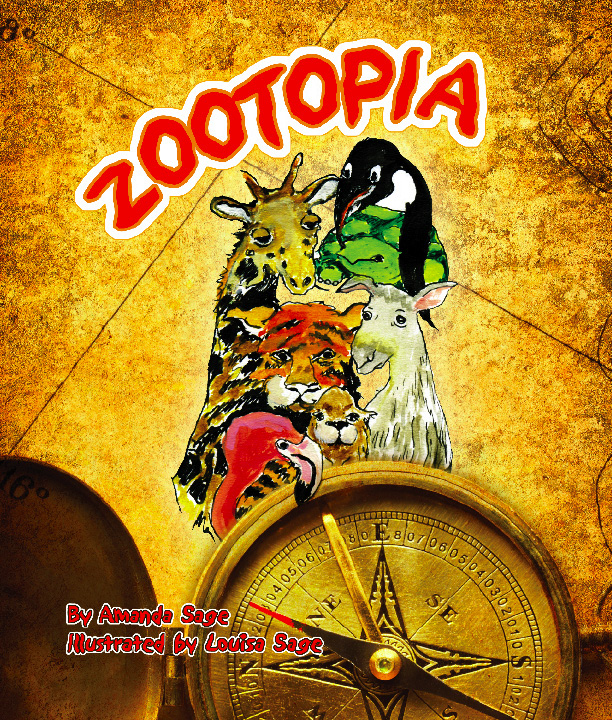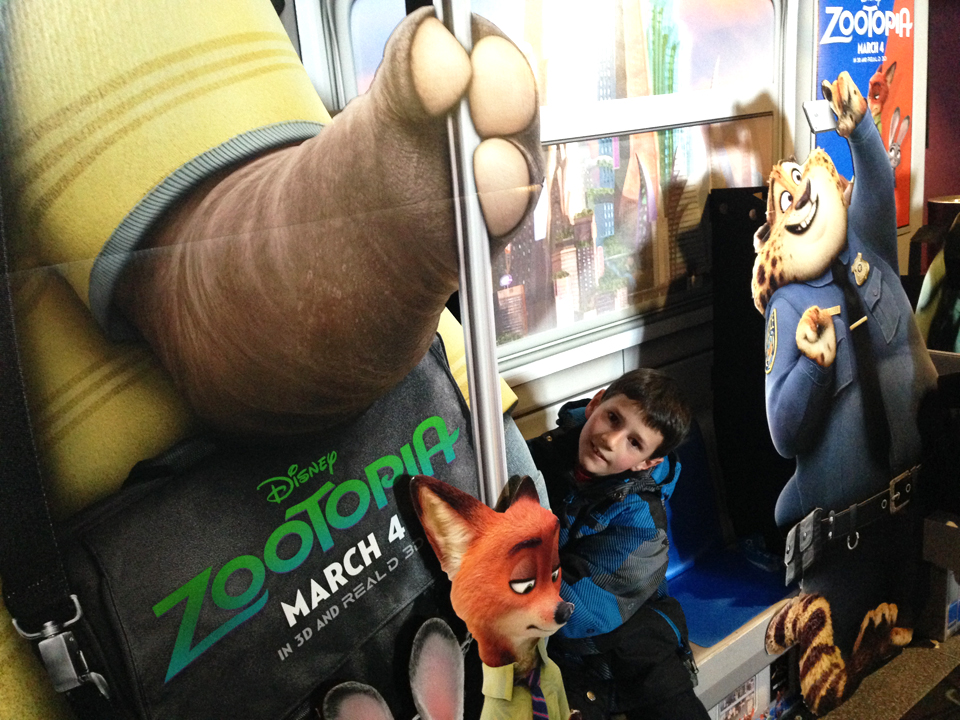Zootopia (feat. David Walberg)
Thursday, April 7th, 2016 1:09 pm—FilmZootopia (USA 2016, Animation/Action/Adventure), Writers: Jared Bush, Phil Johnston; Directors: Byron Howard, Rich Moore, Jared Bush
It’s not often I get to review a movie with one of my three nephews after having watched it together. They’re not from around here, so when we do team up, we all watch the movies separately and then have a chat.
So far, all three boys (Jon, Isaac and David) helped out with The Lego Movie, Jon and I covered The Hunger Games, and he and Isaac both joined me for The Hunger Games: Catching Fire, The Hunger Games: Mockingjay Parts 1 & 2 and Divergent.
This Zootopia review is extra-special to me because I got to take my youngest nephew, eight-year-old David, to see the Disney animated movie while he was visiting. Oh yeah, and also because it steals I mean shares the title of the book I wrote for David in 2010 through my publishing shingle, Wonderpress. (I wasn’t playing favourites; I also wrote Dinostory for Jon and Astrorocket for Isaac.)

We both really enjoyed Zootopia (the movie—though we’re partial to the book, too). Here’s the scene: It’s thousands of years since mammal predators and prey had any trouble co-existing, and a keen young bunny named Judy Hopps (Ginnifer Goodwin) is determined to make her mark in a world where “anyone can be anything.”
Judy bounds out of her hometown, Bunnyburrow, to become the very first bunny cop at the Zootopia Police Department (ZPD). Officer Hopps takes her place alongside a menagerie of other animals, including a buffalo (Chief Bogo, perfectly voiced by Idris Elba), a rhino (Officer McHorn) and a donut-gulping cheetah (Officer Clawhauser, voiced by Nate Torrence). Judy’s relatively small stature doesn’t bode well for her career prospects; while everyone else gets juicy assignments, she’s stuck with parking ticket duty.
Judy tackles her role as meter maid with the same zeal that led her out of the carrot patch and into the sprawling mammal metropolis of Zootopia. But it isn’t long before she scrambles her way onto the city’s biggest case: the 14 missing mammals—all predators. Judy enlists the assistance of Nick Wilde (Jason Bateman), a wily fox and even wilier con artist she’s able to hustle into helping her.
What follows is an interesting examination of the dangers of judging animals by their species, holding pre-conceived notions about others, and prescribing expectations.
When Judy and Nick discover that the missing predators have all gone savage, Zootopia is thrown into unrest, with prey casting sidelong glances at predators. Not that everything was idyllic before the savagery; Judy never reports to work without her can of fox spray, a holdover from her parents’ mistrust of foxes and a frightening encounter from her childhood.
Zootopia’s premise is smart, timely and delivered in a very well wrapped package: Bright, bold animations with meticulous attention to detail (David especially liked the way they moved); a tight, witty, highly polished script; and an inventive world in which the animals can roam and romp.
Zootopia consists of a range of ecologically diverse districts, like Sahara Square, Tundratown and Rainforest District. Little Rodentia was especially charming, with its many roadways and overpasses made of clear plastic hamster tubes. “I liked the rodent town,” says David. “There were lots of gerbils!”
The city is built to accommodate all types of mammals. Elephants are served massive (relative to us) ice cream cones served up (somewhat) fresh by the trunkful. Mice scurry through miniature gateways and get dolled up at small-scale (but high-class) hair salons.
“I liked it when the guinea pigs chomped on the Pawpsicles,” says David. So did I; the several-tiny-bites-sized frozen treats are made in molds formed by Chihuahua footprints in the snow.
Zootopia is a playful, inventive place for Judy and Nick to guide us through a study in race (or in this case, species) relations. The messages are clear, but they extend beyond the obvious ‘Don’t judge a book by its cover’ adage. For example: Be careful what you tell people about themselves; they just might believe it.
The movie does a good job of challenging assumptions, both personal and structural. “It messed around with your expectations,” says David, pointing out a few instances when the story took surprising turns.
I asked him if he thinks all animals—predators and prey—really could get along. “Well, it depends,” says David. “They could get along if they weren’t so smart-mouthed. Like the fox, Nick, you have to admit he was pretty smart-mouthed. But he’s also quick-witted. It’s good to have someone quick-witted around. Or you could just memorize Shakespearean insults like I do. ‘Go to hell for an eternal moment or so.’ That’s from The Merry Wives of Windsor.”
(He actually said that. What a kid.)
David talked a bit more about the film’s central message, and he said something very wise: “No animal really is just one thing. Prey can also be predators—especially humans.”
He’s right. Almost all of us can attack or be attacked.
For an animated children’s film, Zootopia brings a lot to the conversation. As great as it is, though, I thought it missed a couple good opportunities for commentary.
Assistant Mayor Bellwether (Jenny Slate), who is a sheep, remarks that Zootopia is comprised of 90% prey. I expected the movie to draw a parallel to the 99%, with most of the prey being smaller and more vulnerable than the predators. But it didn’t.
Then there was the highly sexualized Gazelle (Shakira), Zootopia’s mammal pop star. We see enough of scantily clad females in everyday media, put in a position where they’re expected to trade in on their bodies for success or recognition; it would have been nice if Disney hadn’t felt the need to ensnare the film’s only icon in a sequined miniskirt and crop top.
I really did like Zootopia, but for a movie so determined to do away with stereotypes, it sure has its share of them. Like the wolves who can’t keep themselves from chiming in once the first howl is released. And the sloths who move at a, well, sloth’s pace.
Mind you, caricaturing sloths leads to a priceless scene at the Department of Mammal Vehicles (DMV) when Judy and Nick drop in to pursue a lead. So, I’m not complaining—just observing.
“The sloths at the DMV were pretty funny,” says David. “It was a good joke.”
In fact, that’s where we first meet David’s favourite character in the movie, Flash the sloth (voiced by Raymond S. Persi).
Zootopia has loads of fun anthropomorphizing the animals, shrewdly reflecting human culture and convention. Judy drew chuckles from the audience when she explains to Officer Clawhauser: “You probably didn’t know, but a bunny can call another bunny cute, but when other animals do it, it’s a little…” Her mortification at seeing animals do yoga naked is also pretty awesome. Or, as David says, “AWKWARD!!!”
After the movie, I asked David whether he’d rather be predator or prey. “Prey. I’d be an elephant. No—a panda. Or a koala.” So, it doesn’t matter if you’re big or small? “Depends who I’m up against. The big ones are more out of control, like I am. That’s a joke.”
David and I both highly recommend this smart-mouthed, fun-loving foray into the animal world. Overall, it’s creative, delightful and clever, and it presents us human animals with some important things to consider.
Oh, and I loved seeing ZTV newscaster Peter Moosebridge, voiced by CBC’s Peter Mansbridge.
And you can buy my version of Zootopia—the children’s book—here.

David aboard the “Zootopia” express
